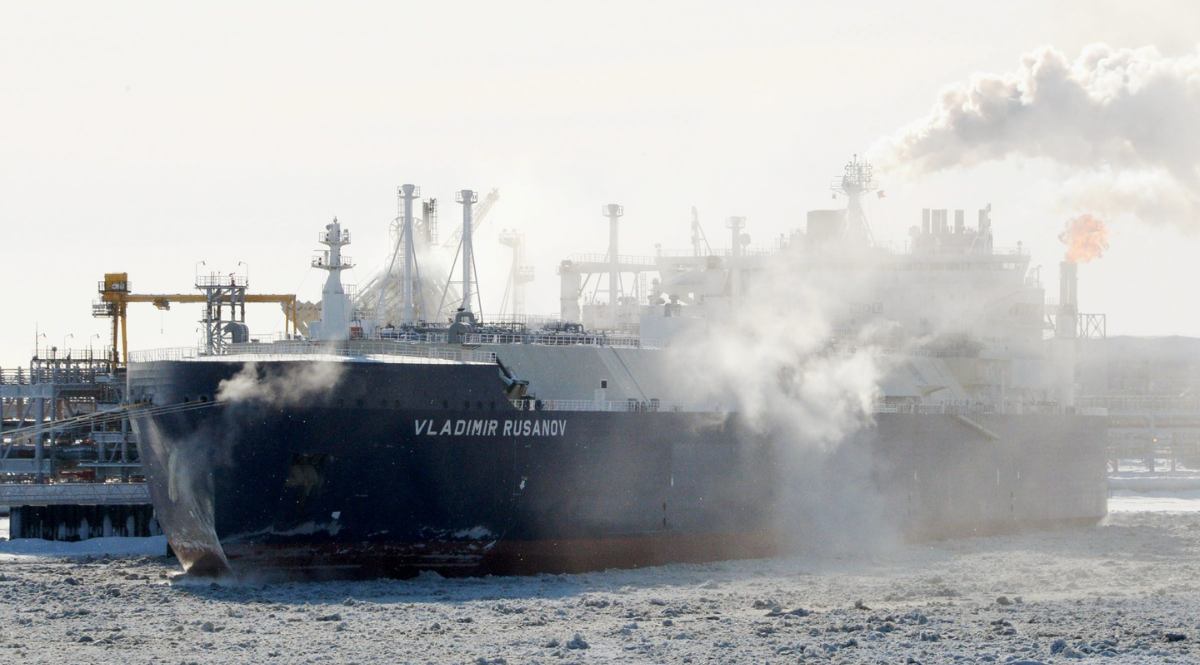Key Takeaways:
I. Despite the EU's efforts to reduce reliance on Russian energy, LNG imports from Russia have paradoxically increased in 2024.
II. Russia is actively adapting to the EU's ban by pivoting towards Asian markets and investing in alternative shipping routes, particularly the Northern Sea Route.
III. The EU's ban carries significant geopolitical risks, impacting both its own energy security and Russia's export strategy.
The European Union's (EU) impending ban on Russian Liquefied Natural Gas (LNG) transshipment, slated for full implementation in early 2025, marks a significant escalation in the ongoing energy standoff between Brussels and Moscow. This policy, enacted in response to Russia's actions in Ukraine, aims to further restrict Russia's energy revenue and limit its influence on European energy markets. However, the ban's effectiveness is far from certain, given the complex dynamics of the global LNG market and Russia's demonstrated adaptability in seeking alternative export routes. This article delves into the multifaceted implications of the EU's ban, examining its potential impact on European energy security, Russia's strategic response, and the evolving landscape of global LNG trade. We will analyze the interplay of market forces, contractual obligations, and geopolitical considerations to provide a nuanced understanding of this critical energy policy decision.
The Paradox of Rising Imports: Deconstructing the EU's LNG Dependence
The EU's pursuit of energy independence from Russia has encountered a significant hurdle: a paradoxical increase in Russian LNG imports during 2024. Despite the impending ban on transshipment and broader efforts to diversify energy sources, the EU has seen an 18% rise in Russian LNG imports, while overall LNG imports have fallen by 11%. This contradictory trend underscores the complexities of disentangling interconnected energy systems and the limitations of sanctions in rapidly achieving energy independence. The European Commission's Q3 2024 report reveals that 20% of the EU's natural gas imports originated from Russia, a two-percentage-point increase from the previous quarter and a five-percentage-point increase year-on-year. Although this represents a 64% decrease compared to Q1 2021, before the Ukraine conflict, the recent uptick raises concerns about the effectiveness of the EU's energy security strategy.
A key driver of this continued reliance on Russian LNG is the prevalence of long-term contracts, many of which predate the current geopolitical tensions and include 'take-or-pay' clauses. These clauses obligate EU companies to purchase specified volumes of gas, regardless of immediate needs or price fluctuations. This contractual rigidity limits the EU's flexibility in responding to geopolitical shifts and creates a financial disincentive to rapidly reduce Russian imports. The dominance of these long-term contracts in the EU's gas supply portfolio explains, in part, the continued flow of Russian LNG, even as the bloc seeks to diversify its sources. This contractual landscape presents a significant challenge to the EU's energy independence goals.
Further complicating the issue is the practice of re-exporting Russian LNG. A significant portion, estimated at over 20%, of the Russian LNG imported into the EU is subsequently shipped to other markets. This loophole effectively undermines the EU's sanctions regime, allowing Russian gas to indirectly reach international buyers and generate revenue for Moscow. In 2023, the EU imported 18 bcm of Russian LNG, with at least 1 bcm re-exported, primarily to Asian markets. This practice raises questions about the transparency and enforceability of the EU's sanctions and highlights the need for a more robust monitoring mechanism to track the flow of Russian LNG and prevent circumvention of the ban.
The EU's gas market operates on a complex mix of long-term contracts indexed to benchmarks like Henry Hub and Brent, and spot market purchases indexed to the Title Transfer Facility (TTF). This dual pricing mechanism creates challenges in predicting the precise impact of the transshipment ban. While the EU has made strides in diversifying its supply, adding over 50 bcm of new LNG import infrastructure since 2022 and becoming the top global LNG importer with 134 bcm imported in 2023 (France leading with 30 bcm), the reliance on Russian LNG persists. The EU's ambitious decarbonization goals, aiming to reduce structural gas demand, further complicate the picture, with potential implications for future LNG import needs and contract management. The interplay of these factors necessitates a strategic reassessment of the EU's gas market mechanisms to ensure both short-term supply security and long-term sustainability.
Russia's Eastern Gambit: Redirecting LNG Flows to Asia
In response to the EU's sanctions and the impending transshipment ban, Russia is actively pursuing a strategic pivot towards Asian markets for its LNG exports. This eastward shift is driven by the imperative to maintain revenue streams and capitalize on the growing energy demand of Asian economies. Russia's existing LNG export infrastructure, including the Yamal LNG project (18.7 million tons shipped in 2023) and Kriogaz-Vysotsk (800,000 tons shipped in 2023), plays a crucial role in this strategy. The EU's ban, while presenting challenges, is unlikely to completely halt Russian LNG exports, as Moscow actively seeks alternative routes and strengthens partnerships with Asian buyers.
Central to Russia's Asian strategy is the development and expansion of alternative shipping routes, most notably the Northern Sea Route (NSR). This Arctic passage offers a significantly shorter distance to Asian markets compared to traditional routes through the Suez Canal. However, the NSR's navigability is severely limited by ice conditions, with a viable window of only 3-4 months during the summer. Russia is investing heavily in icebreaker technology and Arctic port infrastructure to extend this window and potentially enable year-round navigation. The EU's ban on transshipment within its ports further incentivizes Russia to develop the NSR and seek alternative transshipment locations outside the EU, adding logistical complexity and cost considerations to its export strategy.
The Asian LNG market, characterized by a diverse mix of long-term contracts and spot purchases, presents both opportunities and challenges for Russia. Major importers such as China, Japan, South Korea, and India offer substantial market potential. However, competition from established LNG suppliers like Qatar, Australia, and the United States is fierce. Russia's ability to secure market share in Asia will depend on its ability to offer competitive pricing, ensure reliable supply, and navigate the complex geopolitical landscape. The increased presence of Russian LNG in Asia could lead to price fluctuations and reshape regional energy dynamics, creating both winners and losers among suppliers and buyers.
The long-term success of Russia's eastward LNG pivot hinges on several factors. The development of new LNG production projects in the Arctic, such as the planned expansion of the Yamal facility and the construction of new liquefaction plants, is crucial for increasing export capacity. However, EU sanctions restricting the transfer of advanced LNG technology and services to Russia pose a significant obstacle. Russia's ability to secure alternative sources of technology and investment, potentially from Asian partners, will be critical. Furthermore, the evolving geopolitical landscape, including relations with China and other Asian nations, will play a decisive role in shaping Russia's LNG future.
Geopolitical Tremors: Assessing the Broader Impacts of the LNG Ban
The EU's ban on Russian LNG transshipment creates ripple effects across the global energy landscape, impacting not only Russia's export strategy but also the EU's own energy security and the dynamics of the international LNG market. For Russia, the ban translates into increased operational costs due to longer shipping distances and the need to seek alternative transshipment hubs. Estimates suggest that these added logistical challenges could increase operational costs by up to 75%. Furthermore, EU sanctions on technology and services hinder the development of new LNG infrastructure in Russia, potentially slowing its ambition to become a leading global LNG player. This confluence of factors puts pressure on Russia's energy sector and its ability to maintain export volumes.
For the EU, the ban presents a complex set of challenges and opportunities. While aiming to reduce reliance on Russian gas, the interconnected nature of the European gas grid creates vulnerabilities. Indirect gas flows through neighboring countries can circumvent the ban, maintaining a degree of dependence on Russian supply. The EU's position as the top global LNG importer, with 134 bcm imported in 2023, gives it significant market influence, but also exposes it to price volatility and supply disruptions. Furthermore, the EU's ambitious decarbonization goals and long-term energy transition plans, which aim to reduce structural gas demand, add another layer of complexity. The targeted gas demand cut scenario of REPowerEU, if realized by 2030, could shift the EU from a 49 bcm 'under-contracted' status in 2023 to an 'over-contracted' position of 30-40 bcm between 2027 and 2030. This potential surplus of LNG necessitates careful management of long-term contracts and spot market purchases to avoid financial losses and ensure a smooth transition to a lower-carbon energy mix. The interplay of these factors requires a comprehensive and adaptive energy security strategy for the EU.
A New Energy Paradigm: Strategic Implications and Future Outlook
The EU's ban on Russian LNG transshipment represents a pivotal moment in the evolving geopolitics of energy. It underscores the growing tensions between energy security concerns and the imperative for a global energy transition. The ban's effectiveness is intertwined with complex market dynamics, contractual obligations, and Russia's strategic responses. The paradoxical increase in Russian LNG imports to the EU in 2024 highlights the limitations of sanctions and the enduring influence of market forces. Russia's pivot towards Asia and its investments in alternative shipping routes demonstrate its adaptability and determination to maintain its position in the global LNG market. For the EU, the ban presents both challenges and opportunities, requiring a delicate balancing act between reducing reliance on Russian gas, ensuring energy security, and achieving its ambitious decarbonization goals. The interconnectedness of global energy markets and the geopolitical tensions surrounding energy supply chains necessitate a more nuanced and strategic approach. The future of LNG, and indeed the entire energy landscape, is being reshaped by these forces. A successful navigation of this new energy paradigm requires foresight, flexibility, and a deep understanding of the complex interplay between geopolitics, market dynamics, and technological innovation.
----------
Further Reads
I. Europe is set to continue to rely on Russian LNG in short term | S&P Global Commodity Insights
II. European gas market dealing with lower Russian supplies | Atradius

